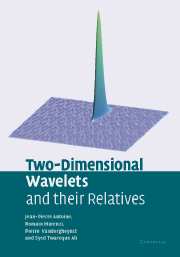Book contents
- Frontmatter
- Contents
- Prologue
- 1 Warm-up: the 1-D continuous wavelet transform
- 2 The 2-D continuous wavelet transform
- 3 Some 2-D wavelets and their performance
- 4 Applications of the 2-D CWT. I: image processing
- 5 Applications of the 2-D CWT. II: physical applications
- 6 Matrix geometry of wavelet analysis. I
- 7 Matrix geometry of wavelet analysis. II
- 8 Minimal uncertainty and Wigner transforms
- 9 Higher-dimensional wavelets
- 10 Spatio-temporal wavelets and motion estimation
- 11 Beyond wavelets
- Epilogue
- Appendix: Some elements of group theory
- References
- Index
Epilogue
Published online by Cambridge University Press: 19 August 2009
- Frontmatter
- Contents
- Prologue
- 1 Warm-up: the 1-D continuous wavelet transform
- 2 The 2-D continuous wavelet transform
- 3 Some 2-D wavelets and their performance
- 4 Applications of the 2-D CWT. I: image processing
- 5 Applications of the 2-D CWT. II: physical applications
- 6 Matrix geometry of wavelet analysis. I
- 7 Matrix geometry of wavelet analysis. II
- 8 Minimal uncertainty and Wigner transforms
- 9 Higher-dimensional wavelets
- 10 Spatio-temporal wavelets and motion estimation
- 11 Beyond wavelets
- Epilogue
- Appendix: Some elements of group theory
- References
- Index
Summary
We may now conclude our overview of the “world according to (2-D) wavelets” [Bur98]. We have thoroughly analyzed the 2-D continuous wavelet transform, given some ideas about the discrete or discretized versions, discussed a large number of applications and generalizations (3-D, sphere, space–time). Where do we go now?
Why wavelets in the first place? When should one use them instead of other methods? Suppose we are facing a new signal or image. The very first question to ask is, what do we want to know or to measure from it? Depending on the answer, wavelets will or will not be useful. If we think they might be, we must next (i) choose a wavelet technique, discrete or continuous; (ii) then select a wavelet well adapted to the signal/image at hand, and (iii) determine the relevant parameter ranges. We emphasize that this approach is totally different from the standard one, based on Fourier methods. There is indeed no parameter to adjust here, the Fourier transform is universal. Wavelets on the other hand are extremely flexible, and the tool must be adapted each time to the situation at hand.
As for the first choice, discrete versus continuous WT, it is a fact that the vast majority of authors use the former, in particular if some data compression is required.
- Type
- Chapter
- Information
- Two-Dimensional Wavelets and their Relatives , pp. 413 - 414Publisher: Cambridge University PressPrint publication year: 2004



